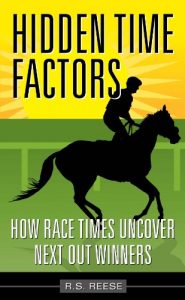Horse racing and handicapping thoroughbred horses can be extremely frustrating, but then there are days when fortune smiles upon you. I should know. I've been handicapping the horses for 15 years as a professional horse handicapper.
I don't toot my horn or scream my head off when I win. I'm quieter than a whisper, but I have a lot of experience of walking to the cash/bet windows to get my money.
Let's just say I know my stuff when it comes to betting the horses.
One of the least talked about aspects of handicapping a race card and track betting is looking at race fractions and applying it to the performance of a horse. As handicappers we are looking at old data, trying to apply it to new variables.
For example, today's race. How will the horse handle this competition? This track? This distance? The weather? And on and on the questions go.
What makes race times so important in helping us pick winners is that the past leaves clues that will help us be successful today. Even a trainer trying to hide a horse's form in many cases can't escape our scrutiny based on how we analyze the racing data.
This simple little book explains how to look at a horse's last race in the racing form and by adding or subtracting a few numbers in a special way allow us to arrive at a number that isolates the main contenders of a race.
Of course it doesn't always work. This is horse racing after all, but in the examples presented from 27 different races over 5 different tracks the winning horse came from the top two time figures in nearly 60% of the races.
This is not a favorites method or a longshot method, but a way to look at hidden times most handicappers can't see--and the best part is that you can analyze each race in a matter of minutes.
I don't toot my horn or scream my head off when I win. I'm quieter than a whisper, but I have a lot of experience of walking to the cash/bet windows to get my money.
Let's just say I know my stuff when it comes to betting the horses.
One of the least talked about aspects of handicapping a race card and track betting is looking at race fractions and applying it to the performance of a horse. As handicappers we are looking at old data, trying to apply it to new variables.
For example, today's race. How will the horse handle this competition? This track? This distance? The weather? And on and on the questions go.
What makes race times so important in helping us pick winners is that the past leaves clues that will help us be successful today. Even a trainer trying to hide a horse's form in many cases can't escape our scrutiny based on how we analyze the racing data.
This simple little book explains how to look at a horse's last race in the racing form and by adding or subtracting a few numbers in a special way allow us to arrive at a number that isolates the main contenders of a race.
Of course it doesn't always work. This is horse racing after all, but in the examples presented from 27 different races over 5 different tracks the winning horse came from the top two time figures in nearly 60% of the races.
This is not a favorites method or a longshot method, but a way to look at hidden times most handicappers can't see--and the best part is that you can analyze each race in a matter of minutes.



